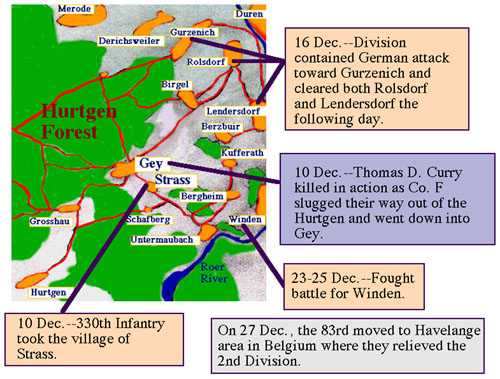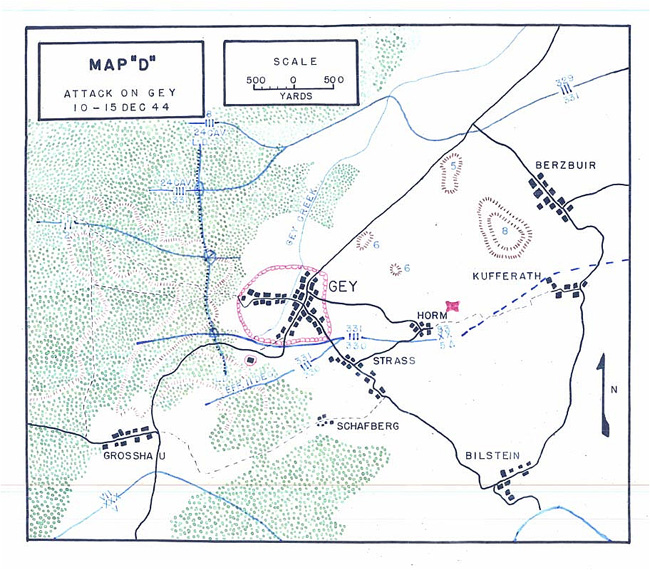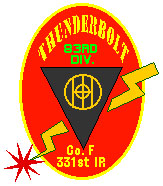

"The Regiment's plan of attack was for the 2nd Battalion with a platoon of tanks and the Anti-Tank Mine Platoon attached, to attack Gey from the edge of the woods west of the town. The attack was to jump off at 0600 on 10 December, about one hour before daylight, following a heavy artillery preparation and supported by the Heavy Weapons Companies of the 1st and 3rd Battalions. The 3rd Battalion was to occupy positions of the 2nd Battalion and be prepared to pass through Gey after its seizure and take the ridge southwest of Berzbuir and Lendersdorf. The 1st Battalion was to remain in position and block the enemy in the woods north of Gey.
The 2nd Battalion's plan of attack called for E and F Companies to make a direct frontal assault from the edge of the woods. E Company, on the right, to attack across the open terrain betwen the west and south legs of town and seize the south and southeast portions. F Company, with a platoon of tanks attached, was to seize the west and north parts of town. G Company was to protect the right flank of the battalion from positions along Gey Creek near the right limiting point and be prepared to attack Gey from the southwest.
The 2nd Battalion jumped off at 0600, but ran into difficulty immedately. F Company got a good start and secured the first buildings on the edge of town. E Company, however, was detected before it overran the enemy outpost and heavy artillery, mortar, and small arms fire caught them in the open area southwest of town. The company continued forward until it ran into a barbed wire entanglement which had not been reported by patrols. Unable to advance and suffering casualties from the heavy fire the men sideslipped to the left and became intermingled with F Company. With the intermingling, both companies became disorganized and the attack bogged down except for some of the leading elements of F Company which had pushed on ahead.
By 1100 hours the leading elements of F Company had advanced to a point about 100 yards west of Gey Creek against very determined resistance. The Company Commander, who was with this group, held up the attack because the group was considerably weakened by casualties and the remainder of the company was not following up the assault echelon. Enemy fire was increasing. Machine guns were firing on the attacking troops from positions at the northern and southern ends of town. Enemy artillery fire was pounding the western end of town and the edge of the woods with the heaviest artillery and mortar concentrations ever experienced by members of the regiment.
In the meantime, the platoon of tanks had been trying to move up on the road leading into town from the west. The road was narrow and muddy, and after a great deal of difficulty the lead tank got to within 100 yards of the edge of town where it hit a mine. This happened in a narrow defile where it was impossible to get any other tanks around it. Efforts to get the tank out were started immediately, but because of the difficulty of working in the resticted area under enemy artillery fire the road was not cleared until after dark that night.

It was not until 1100 that the Regimental Commander was informed of the true situation. The battalion had reported the progress of F Company hoping to be able to get F and E Companies reorganized and the attack moving. The Regimental Commander immediately went forward to contact the 2nd Battalion Commander. Investigation revealed that enemy observation and fire precluded the possibility of any effective reorganization and resumption of the attack by E and F Companies.
Reports from the 2nd Battalion and from prisoners captured in Gey indicated that the buildings in the town had thick walls through which the enemy had blown holes for use as firing ports, and deep basements into which the enemy moved during our artillery fire. There were mines and booby traps in the yards around the houses and dug-in positions in the fields outside the town. Prisoners also reported that there was approximately a battalion in Gey and another one on the ridge about 2200 yards to the northeast, and that they had seen several anti-tank guns a short distance to the northeast of Gey.
G Company with one platoon of tanks attached, was ordered to attack Gey along the Grosshau-Gey road. However, upon the receipt of information that Strass had been taken and a report of a large mine field on the Grosshau-Gey road, the plan was changed. One platoon of G Company plus one platooon of tanks was to move through Grosshau, Schafberg, and Strass for an attack on Gey from the southwest. Permission was obtained from the 330th Infantry for movement of this task force and it moved out on its mission.
Strass, however, had been erroneously reported as captured. Two companies of the 3rd Battalion, 330th Infantry, had gotten into the town but had not cleared it. The enemy had cut these units off and when the G Company task force attempted to enter the town it became engaged in a fight, knocked out two enemy tanks, and withdrew. This erroneous information had unnecessarily endangered the lives of the men involved and disrupted another attack on Gey."
